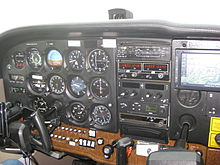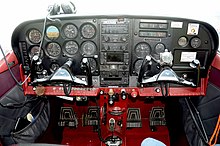cockpit

The cockpit (also known as the cockpit or flight deck ) is part of an aircraft and the workplace of pilots and, if necessary, of a flight engineer . Its counterpart on large airships is the command bridge . Control is carried out from the cockpit . In addition, the flight and technical processes are initiated and controlled here.
Location and distribution

The cockpit is almost always located on the front of the aircraft behind the aircraft nose and mostly directly behind the radar antenna or, in the case of cargo aircraft, with a bow loading flap above the aircraft nose. The captain and possibly his co-pilot sit in the direction of flight. In fixed-wing aircraft , the captain usually sits to the left of the co-pilot , in helicopters on the right. In most multi-seat combat aircraft , the pilot and the weapons system officer sit one behind the other due to a lack of space and communicate using an intercom. Even in two-seat gliders or aerobatic machines, the pilot and co-pilot usually sit one behind the other in order to enable a slimmer fuselage.
The flight engineer, if provided, usually sits behind the co-pilot on large aircraft, with a view of his instruments on the starboard side. He usually sits across the direction of flight on his swivel chair, except for takeoff and landing. The navigator (which still existed in the cockpit of larger aircraft until the 1970s, as well as a radio operator even earlier) sat a little further back (to leave a passage free), mostly behind the captain, across the direction of flight View of his instruments on the port side.
Larger aircraft have a separate cockpit so that disruptions to work are avoided. The first aircraft with a sealed cabin was the 1913 The Grand aircraft by Igor Ivanovich Sikorski .
Furnishing
In the cockpit of a modern airliner there are several hundred operating and control elements for operation, control, monitoring, navigation, communication and the operational process. For example, the cockpit of the Boeing 747-300 contains 971 controls and displays. With the advancement of computer technology , the number has become smaller and smaller; today it is around 300 for wide-body aircraft. More information can be called up today, but not all of them are displayed at the same time. Many functions are now operated via the menu structure of the flight management systems .
control

The most important control elements are the control horn or the control stick , today also sidesticks , for elevator and ailerons , pedals for rudder and wheel brakes , throttle or thrust levers and levers for operating the lift aids , the spoilers and the landing gear , as well as handwheels for the nose wheel control Roll on the floor. In older models, mechanical elements are controlled by cables , today fly-by-wire is used in large aircraft .
Furthermore, the operating units of the find in the cockpit radios , the flight management system , the autopilot and possibly automatic thrust control systems, the breaker , the fire extinguishing systems , the intercom , etc.
Instruments

DHC-6 Twin Otter
Important instruments are the airspeed indicator , the artificial horizon , the altimeter , the vertical speed , the directional gyro , the compass , the tachometer , the turn indicator , the radio compass , the ON annunciator, the fuel quantity indication, the oil pressure and oil temperature gauge and boost gauge.
In modern aircraft, one speaks of an Electronic Flight Instrument System (EFIS). In contrast to classic instruments, it increasingly contains screens on which the information is processed and graphically displayed depending on the situation.
lighting
Other equipment
The cockpit also contains documents such as manuals, maps, radio frequency lists and other important written lists. The numerous on-board computers in commercial aircraft are usually located under or behind the cockpit.
The displays are mainly arranged in front of the body below the pilot's line of sight , while most of the switches and control lights on commercial aircraft are located above the head or across the direction of flight.
For night flights , all displays must be illuminated, and at least one functional flashlight must also be carried. Modern cockpits are equipped with computer technology; so you will find a variety of large and small monitors here . The actual computers of the avionics are usually located in modern airliners in a room below and / or behind the cockpit. Electronic flight information systems (EFIS), also known as “glass cockpits”, are the latest technology .
Pilots usually wear headphones or headsets , which are often designed as noise-reducing headphones to reduce ambient noise and to relieve the pilots' hearing . To protect against air pirates , the doors to the cabin on passenger aircraft are now locked and armored. In fighter aircraft, the pilots' seats are designed as ejection seats. When triggered, the glass dome is blown away. Emergency exits are usually only available in larger aircraft.
window
The cockpit windows of smaller aircraft are usually made of Plexiglas , while larger and combat aircraft are usually made of laminated safety glass .
In commercial aircraft, the windows are usually anti-reflective , often have wipers on the windshield and can be partially wetted there with a water-repellent liquid, the "rain repellent".
In addition, cockpit windows can contain an optically largely transparent, but electrically conductive intermediate layer, with the aid of which the windows can be heated.
Usually there are sun visors on the front, sometimes on the side. The side windows can be opened for many designs. Some types of aircraft and many helicopters also have windows for viewing downwards laterally and frontally.
Some types of military aircraft used to have windows in the floor so that the gunner could see enemy fighters attacking from below (see also weird music ) and fight them with on-board weapons . Often these windows were installed below the cockpit.
See also
- Cockpit , the cockpit of a sailing or motor boat


